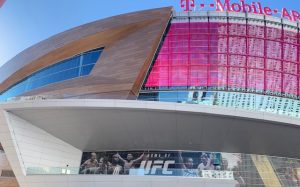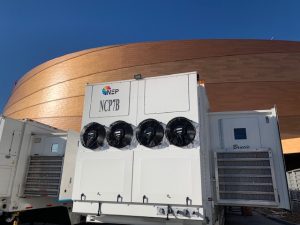UFC 246: Conor McGregor’s Return to the Octagon Packs a Hefty Production Punch
Production partner Concom rolls out high-tech show at T-Mobile Arena
Story Highlights
Conor McGregor’s long-awaited return to the Octagon for UFC 246 tomorrow night is expected to generate plenty of fireworks and, judging by his history, even more PPV buys for ESPN+. With ample eyeballs expected to be glued to The Notorious’s showdown with Donald “Cowboy” Cerrone Saturday, UFC’s longtime production partner Concom has rolled out a large arsenal of production firepower at Las Vegas’s T-Mobile Arena, including a JITACam and augmented-reality graphics.
“This is definitely one of the larger PPVs we have ever done,” says Greg Louw, director, technical operations, Concom, “and it would actually be even larger if we had more load-in time at the arena. Obviously, we’ve done [UFC events] in several stadiums where it’s a larger show just because of the size of the venue, but this is definitely one of the largest PPV shows we’ve ever done at a domestic arena.”
A Tight Timetable: Single-Day Set, Shoot, Strike
Concom, which has provided turnkey production solutions to the UFC for both in-venue and broadcast operations since 1997, facilitates everything from in-house lighting, projection, and PA to broadcast and transmission.
As UFC’s schedule has become demanding and venues have grown busier, Concom is often forced to set, shoot, and strike PPV shows in a single day — as will be the case Saturday. Because T-Mobile hosted a Google corporate event on Thursday and a Tool concert on Friday night, Concom won’t have access to the floor until roughly 3 a.m. Saturday morning.
“It’s an overnight load-in, which we’ve actually become accustomed to over the past few years,” says Louw. “These PPV events have grown over the years, and the biggest challenge now is trying to do more with less time allotted because the venues are so busy. Our goal over the past three or four years has been streamlining everything so the entire show is cleaner. That was the only way to make it sustainable, and I think we did a really good job of accomplishing that.”
The Weigh-In: UFC Takes Over Park Theater
Vegas is already abuzz with excitement for the return of UFC’s biggest star, and the festivities kick off at 6 p.m. ET with the weigh-in at the Park Theater, an MGM property adjacent to T-Mobile Arena (also an MGM property).
Concom has rolled out a separate mobile production unit, NEP’s M15, at the Park Theater since its primary truck, NEP’s NCPVII, will be prepping for the fight at T-Mobile Arena. Typically, Concom deploys three cameras for a weigh-in, but, with McGregor expected to draw a full house at the theater and countless more watching on the UFC YouTube channel, that number will double to six cameras (all Grass Valley LDX 86N’s): three hard, two handheld, and a jib.
“It will definitely be a larger [production] than a usual weigh-in,” says Louw. “Considering the size of the PPV and the full-house crowd [at the weigh-in], we’re upping the ante on this one.”
The live stream will also be fed to the LED ribbon board outside T-Mobile Arena and to the LED board in Toshiba Plaza (home to the Golden Knights) for crowds outside to view what is expected to be a lively weigh-in.
“The whole environment in that area should be pretty electric,” says Louw.
Inside the Octagon: JITACam, Sony HDC-4300’s Play Key Roles
For the fight itself, 16 cameras will be arrayed throughout T-Mobile Arena with four cameras dedicated to the Octagon: a JITACam (jib in the air) system above, two Sony HDC-4300’s (running at 6X slo-mo) on the left and right, and a Sony HDC-2500 reverse shot.
“What makes our sport unique,” Louw notes, “is that we have the luxury of having all the action take place within a 30-ft. circumference around that Octagon, so we get really great coverage with just four handheld cameras. Two of them are 4300’s at 6X speed, which account for 90% of our slo-mo replays. Those allow us to get those really dramatic shots of the fighters’ faces and big hits off just two cameras, which is advantageous to us and makes for some really amazing pictures.”
The JITACam has become an integral component of UFC coverage after Concom incorporated a 30-ft. rail system allowing the JITACam not only to rotate but also to travel back and forth across the Octagon.
“We were the first to utilize the JITA in combat sports,” says Louw, “and that rail system has been a difference-maker for us. We use it as one of our four coverage cameras on the Octagon during the fights, and then it pulls back on the rail and spins around between fights to get wider shots.”
Typically, Concom installs a DynamiCam mini aerial system for larger PPV events but opted not to for UFC 246 given the extremely limited load-in time.
The production team will also have at their disposal two RF cameras (one covering the crowd inside the bowl, the second serving a backstage Facebook Live show) and a robo.
Augmented Reality: UFC Gets Virtual With AR in Toshiba Plaza
Concom, UFC, and ESPN are also teaming up with Girraphic and Stype to create augmented-reality graphics for the event. The AR graphics will be featured on a jib outside the arena in Toshiba Plaza. This marks the second such collaboration, following a sizable AR deployment at UFC 243 in Melbourne, Australia.
“We’re really excited to be doing AR graphics; it’s not something that we do normally,” says Louw. “We’ll have a jib floating in the plaza over the crowd that [can be] cut to for AR graphics like tale-of-the-tape and [comparisons between] fighters. We think it will give [viewers] a better sense of place and add more of that Vegas feel. It went well when we did it [at UFC 243], so we’re hoping to build on that here.”
Inside the Truck Compound: NCPVII and UFC’s Custom B unit
NEP’s NCPVII, which is used for all UFC PPVs, is already being prepped at the T-Mobile Arena truck dock and will serve as the hub for Saturday night’s production.
UFC’s custom-built B unit, which debuted in April, also is on hand to serve the unique needs of a UFC show. It is equipped with a Grass Valley Karrera switcher that uses two M/Es from NCPVII’s GVG Kayenne X-Frame switcher. The B unit also features an EVS replay system tied into the main-truck EVS network, a separate Vizrt graphics system, and a Calrec Brio audio console in the audio room.
“It has been great for us because it’s like a second production gallery,” says Louw. “Having the same main truck [NCPVII] and the B unit dedicated to all our shows has streamlined things and made all the difference in the world.”
The Scene Backstage: Facebook Live Goes Behind the Curtain
Although the B unit typically handles ESPN’s onsite studio show for non-PPV UFC events (ESPN produces its own shoulder programming for PPVs), the truck will be used for the backstage Facebook Live show at UFC 246. This production will feature a dedicated wireless RF camera and offer interviews with fighters and their camps leading up to the fight.
“This is our third event doing the backstage Facebook Live show, and it’s starting to get some traction,” says Louw. “Obviously, there is no actual fight action on Facebook Live; it will solely be formatted interviews. It’s not a constant stream; we will give [viewers] a heads up that, in five minutes, we’re going backstage to talk to one of the fighters so they know to tune in.”
Audio and Comms: A Constant Evolution
As one of the most intimate — and brutal — sports on the planet, MMA events have always emphasized audio. With that in mind, Concom and UFC continue to adjust the microphone complement around the Octagon in an effort to capture the best possible audio. Recently, two overhead Sennheiser shotgun mics were lowered closer to the action in the Octagon, and, according to Louw, the move significantly boosted in the audio quality.
“Although we’ve been very proud of the audio we create, we are always trying to improve upon it,” says Louw. “Lowering those overhead mics has made a huge difference, and we feel like our audio is better than it has ever been. We’ve seen other [combat-sports productions] have a whole array of mics, and we’ve tried that, but just lowering those two mics has done the trick. We even put this 1970s-era bass-drum mic under the Octagon, and that’s how we pick up the majority of the sounds when they hit the Octagon. It’s simple, but it’s absolutely amazing sound.”
As the size of Concom’s UFC productions has grown, so too have its communications needs. Recently, Concom incorporated Riedel’s Bolero RF wireless intercom and now has more than two dozen RF PLs deployed.
“The flexibility the Boleros offer in terms of coverage is just amazing,” says Louw. “Plus, you can get up to six channels easily on one beltpack. It’s especially great for the tech managers because we can hear everybody no matter where they are as we walk around [the venue]. That was never possible before.”
Of course, while technology continues to play a major role in enhancing Concom’s UFC productions, Louw says, the core crew remains key to delivering a high-quality show for the fans.
“When it comes down to it,” he explains, “the core crew that Concom provides is what makes these shows exceptional, especially on an overnight load-in like this. Without our amazing team, there is no way we could put on such an amazing overall in-venue and at-home experience for the fans.”


